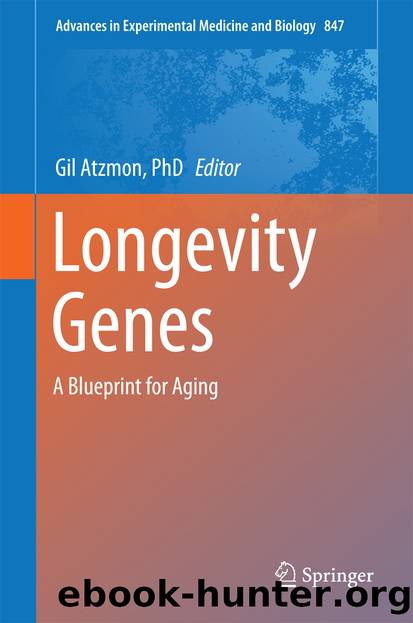Longevity Genes by Gil Atzmon

Author:Gil Atzmon
Language: eng
Format: epub
Publisher: Springer New York, New York, NY
The Mitochondrial Energy Metabolism and Age-Related Phenotypes
Mitochondria harbor the most efficient energy producing cellular machinery, the oxidative phosphorylation (OXPHOS). This machinery is operated by five multi-subunit protein complexes harboring ~ 80 polypeptides: NADH unibiquinone oxidoreductase (complex I), Succinate unibiquinone oxidoreductase (complex II), Ubiquinol cytochrome c oxidoreductase (complex III), Cytochrome c oxidase (complex IV), and ATP synthase (complex V). Four of these complexes (complexes I, III-V) harbor subunits encoded both by the mitochondrial DNA (mtDNA) and the nuclear genome with the former evolving an order of magnitude faster than the latter (see detailed discussion below) [5]. It has been shown that the interactions between mtDNA and nuclear DNA-encoded factors are essential for mitochondrial activity and for the health status of the organism [6–8]. Hence, it is not surprising that many studies, including research performed by our group, revealed association of common genetic variants within genes encoded by both the mitochondrial and nuclear genomes with altered susceptibility to age-related disorders [9]. Accordingly, nuclear DNA-encoded modifying factors altered the penetrance of mtDNA disease causing mutations [6, 7, 10]. Taken together, the interactions between mtDNA and nuclear DNA-encoded factors are important for mitochondrial activity and for the life of the organism; additionally it is plausible that some mitochondrial-nucleus genotype combinations are more beneficial than others (see below detailed discussion).
Since the 1950’s mitochondrial involvement in the ageing process has been suspected to occur mainly via the so-called ‘vicious cycle’ [11, 12]. This suggestion is based on the by-products of the energy producing activity of the mitochondria—the reactive oxygen species (ROS), which was thoroughly discussed elsewhere [13] and will not be the focus of this chapter. However, with this in mind, it is noteworthy that fast aging mice, overexpressing a mutant DNA polymerase gamma (Pol-gamma), the main mtDNA polymerase, had elevated mtDNA mutation rate with no excess of ROS, thus questioning the role of ROS in the so-called ‘vicious cycle’ of ageing [14]. This is in contrast to directed delivery of catalase, a player in the antioxidant stress response machinery, to the mitochondria in mice which extended their maximum life span [12]). Therefore, the accumulation of mtDNA damage over the lifetime of the individual and its role in ageing, still nourish a lively debate [13, 15]. Nevertheless the involvement of mtDNA variability in ageing has compelling evidence that will be discussed here.
Download
This site does not store any files on its server. We only index and link to content provided by other sites. Please contact the content providers to delete copyright contents if any and email us, we'll remove relevant links or contents immediately.
Sapiens: A Brief History of Humankind by Yuval Noah Harari(14171)
Sapiens by Yuval Noah Harari(5269)
Pale Blue Dot by Carl Sagan(4867)
Homo Deus: A Brief History of Tomorrow by Yuval Noah Harari(4781)
Livewired by David Eagleman(3628)
Origin Story: A Big History of Everything by David Christian(3595)
Brief Answers to the Big Questions by Stephen Hawking(3321)
Inferior by Angela Saini(3213)
Origin Story by David Christian(3121)
The Gene: An Intimate History by Siddhartha Mukherjee(3015)
Signature in the Cell: DNA and the Evidence for Intelligent Design by Stephen C. Meyer(3003)
The Evolution of Beauty by Richard O. Prum(2918)
Aliens by Jim Al-Khalili(2767)
How The Mind Works by Steven Pinker(2701)
A Short History of Nearly Everything by Bryson Bill(2585)
Sex at Dawn: The Prehistoric Origins of Modern Sexuality by Ryan Christopher(2444)
From Bacteria to Bach and Back by Daniel C. Dennett(2426)
Endless Forms Most Beautiful by Sean B. Carroll(2406)
Who We Are and How We Got Here by David Reich(2377)
